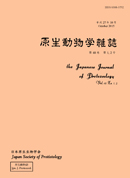巻号一覧

44 巻 (2011)
- 2 号 p. 89-
- 1 号 p. 1-
44 巻, 1 号
選択された号の論文の1件中1~1を表示しています
- |<
- <
- 1
- >
- >|
Review
-
Yuuki Kodama, Masahiro Fujishima2011 年 44 巻 1 号 p. 1-20
発行日: 2011年
公開日: 2016/08/01
ジャーナル フリーEach symbiotic Chlorella of the ciliate Paramecium bursaria is enclosed in a perialgal vacuole (PV) derived from the host digestive vacuole (DV) to protect from lysosomal fusion. Irrespective of the mutual relationships between P. bursaria and their symbiotic algae, the alga-free paramecia and symbiotic algae still have an ability to grow independently and can be experimentally reinfected by mixing them. This phenomenon provides an excellent opportunity to elucidate cell-to-cell interactions between protozoa and algae during establishment of the secondary endosymbiosis. However, the detailed algal reinfection process had been unclear. Therefore, using pulse-label of the alga-free paramecia with the isolated symbiotic algae and chase method, we found four important cytological events needed to establish endosymbiosis. (1) 3 min after mixing, some algae show resistance to the host lysosomal enzymes in the DVs even if the digested ones are coexisted. (2) 30 min after mixing, the alga starts to leave from the DV to appear in the cytoplasm by budding of the DV membrane. (3) Within 15 min after the algal appearance in the cytoplasm, the vacuole enclosing a single green alga differentiates into the PV from the DV, which gives protection from the host lysosomal fusion. (4) After that, the alga localizes beneath the host cell cortex. At about 24 h after mixing, the alga increases by cell division and establishes endosymbiosis. In this review article, we describe our recent studies on the four events during the algal reinfection process.抄録全体を表示PDF形式でダウンロード (2388K)
- |<
- <
- 1
- >
- >|